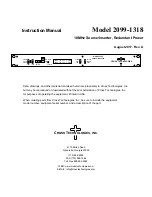
2-14
DSP56367
MOTOROLA
Signal/Connection Descriptions
Serial Host Interface
MOSI
Input or
output
Tri-stated
SPI Master-Out-Slave-In—When the SPI is configured as a master, MOSI is the master
data output line. The MOSI signal is used in conjunction with the MISO signal for
transmitting and receiving serial data. MOSI is the slave data input line when the SPI is
configured as a slave. This signal is a Schmitt-trigger input when configured for the SPI
Slave mode.
HA0
Input
I
2
C Slave Address 0—This signal uses a Schmitt-trigger input when configured for the I
2
C
mode. When configured for I
2
C slave mode, the HA0 signal is used to form the slave device
address. HA0 is ignored when configured for the I
2
C master mode.
This signal is tri-stated during hardware, software, and individual reset. Thus, there is no
need for an external pull-up in this state.
This input is 3.3V tolerant.
SS
Input
Tri-stated
SPI Slave Select—This signal is an active low Schmitt-trigger input when configured for
the SPI mode. When configured for the SPI Slave mode, this signal is used to enable the SPI
slave for transfer. When configured for the SPI master mode, this signal should be kept
deasserted (pulled high). If it is asserted while configured as SPI master, a bus error
condition is flagged. If SS is deasserted, the SHI ignores SCK clocks and keeps the MISO
output signal in the high-impedance state.
HA2
Input
I
2
C Slave Address 2—This signal uses a Schmitt-trigger input when configured for the I
2
C
mode. When configured for the I
2
C Slave mode, the HA2 signal is used to form the slave
device address. HA2 is ignored in the I
2
C master mode.
This signal is tri-stated during hardware, software, and individual reset. Thus, there is no
need for an external pull-up in this state.
This input is 3.3V tolerant.
HREQ
Input or
Output
Tri-stated
Host Request—This signal is an active low Schmitt-trigger input when configured for the
master mode but an active low output when configured for the slave mode.
When configured for the slave mode, HREQ is asserted to indicate that the SHI is ready for
the next data word transfer and deasserted at the first clock pulse of the new data word
transfer. When configured for the master mode, HREQ is an input. When asserted by the
external slave device, it will trigger the start of the data word transfer by the master. After
finishing the data word transfer, the master will await the next assertion of HREQ to proceed
to the next transfer.
This signal is tri-stated during hardware, software, personal reset, or when the
HREQ1–HREQ0 bits in the HCSR are cleared. There is no need for external pull-up in this
state.
This input is 3.3V tolerant.
Table 2-10 Serial Host Interface Signals (Continued)
Signal
Name
Signal Type
State
during
Reset
Signal Description
Summary of Contents for DSP56367
Page 16: ...xvi MOTOROLA CONTENTS Paragraph Number Title Page Number ...
Page 22: ...xxii MOTOROLA List of Figures Figure Number Title Page Number ...
Page 26: ...xxvi MOTOROLA List of Tables Table Number Title Page Number ...
Page 148: ...4 6 DSP56367 MOTOROLA Design Considerations PLL Performance Issues ...
Page 248: ...9 30 DSP56367 MOTOROLA Serial Host Interface SHI Programming Considerations ...
Page 306: ...10 58 DSP56367 MOTOROLA Enhanced Serial Audio Interface ESAI ESAI Initialization Examples ...
Page 389: ...Bootstrap ROM Contents MOTOROLA DSP56367 A 15 end ...
Page 390: ...A 16 DSP56367 MOTOROLA Bootstrap ROM Contents ...
Page 432: ...C 8 DSP56367 MOTOROLA JTAG BSDL ...
Page 484: ...D 52 DSP56367 MOTOROLA Programmer s Reference ...
Page 490: ...E 6 DSP56367 MOTOROLA Power Consumption Benchmark ...
Page 516: ...F 26 DSP56367 MOTOROLA IBIS Model ...
Page 522: ...Index 6 MOTOROLA Index ...
Page 523: ......















































